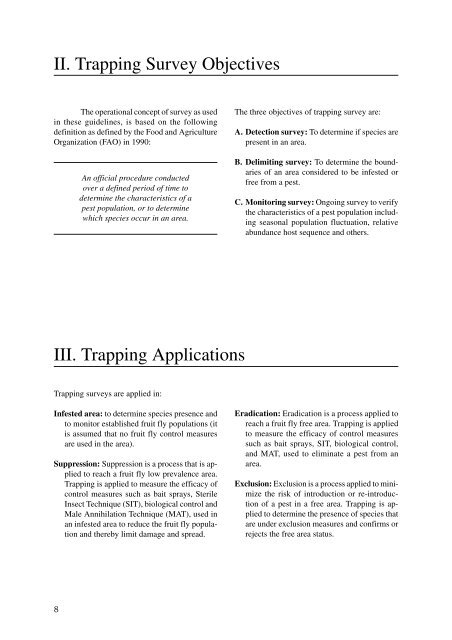Fruit fly trapping guide - IAEA Publications - International Atomic ...
Fruit fly trapping guide - IAEA Publications - International Atomic ...
Fruit fly trapping guide - IAEA Publications - International Atomic ...
Create successful ePaper yourself
Turn your PDF publications into a flip-book with our unique Google optimized e-Paper software.
II. Trapping Survey Objectives<br />
The operational concept of survey as used<br />
in these <strong>guide</strong>lines, is based on the following<br />
definition as defined by the Food and Agriculture<br />
Organization (FAO) in 1990:<br />
An official procedure conducted<br />
over a defined period of time to<br />
determine the characteristics of a<br />
pest population, or to determine<br />
which species occur in an area.<br />
The three objectives of <strong>trapping</strong> survey are:<br />
A. Detection survey: To determine if species are<br />
present in an area.<br />
B. Delimiting survey: To determine the boundaries<br />
of an area considered to be infested or<br />
free from a pest.<br />
C. Monitoring survey: Ongoing survey to verify<br />
the characteristics of a pest population including<br />
seasonal population fluctuation, relative<br />
abundance host sequence and others.<br />
III. Trapping Applications<br />
Trapping surveys are applied in:<br />
Infested area: to determine species presence and<br />
to monitor established fruit <strong>fly</strong> populations (it<br />
is assumed that no fruit <strong>fly</strong> control measures<br />
are used in the area).<br />
Suppression: Suppression is a process that is applied<br />
to reach a fruit <strong>fly</strong> low prevalence area.<br />
Trapping is applied to measure the efficacy of<br />
control measures such as bait sprays, Sterile<br />
Insect Technique (SIT), biological control and<br />
Male Annihilation Technique (MAT), used in<br />
an infested area to reduce the fruit <strong>fly</strong> population<br />
and thereby limit damage and spread.<br />
Eradication: Eradication is a process applied to<br />
reach a fruit <strong>fly</strong> free area. Trapping is applied<br />
to measure the efficacy of control measures<br />
such as bait sprays, SIT, biological control,<br />
and MAT, used to eliminate a pest from an<br />
area.<br />
Exclusion: Exclusion is a process applied to minimize<br />
the risk of introduction or re-introduction<br />
of a pest in a free area. Trapping is applied<br />
to determine the presence of species that<br />
are under exclusion measures and confirms or<br />
rejects the free area status.<br />
8













